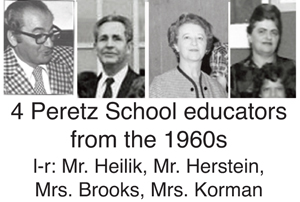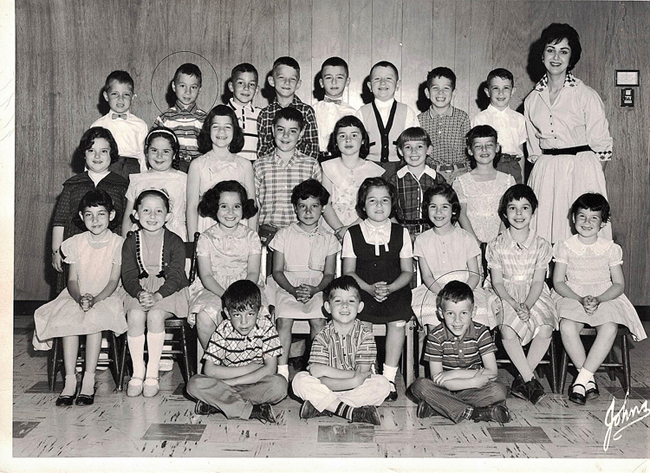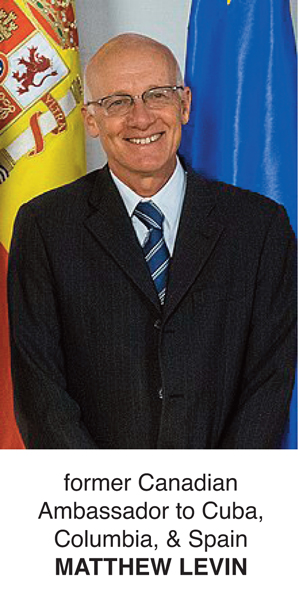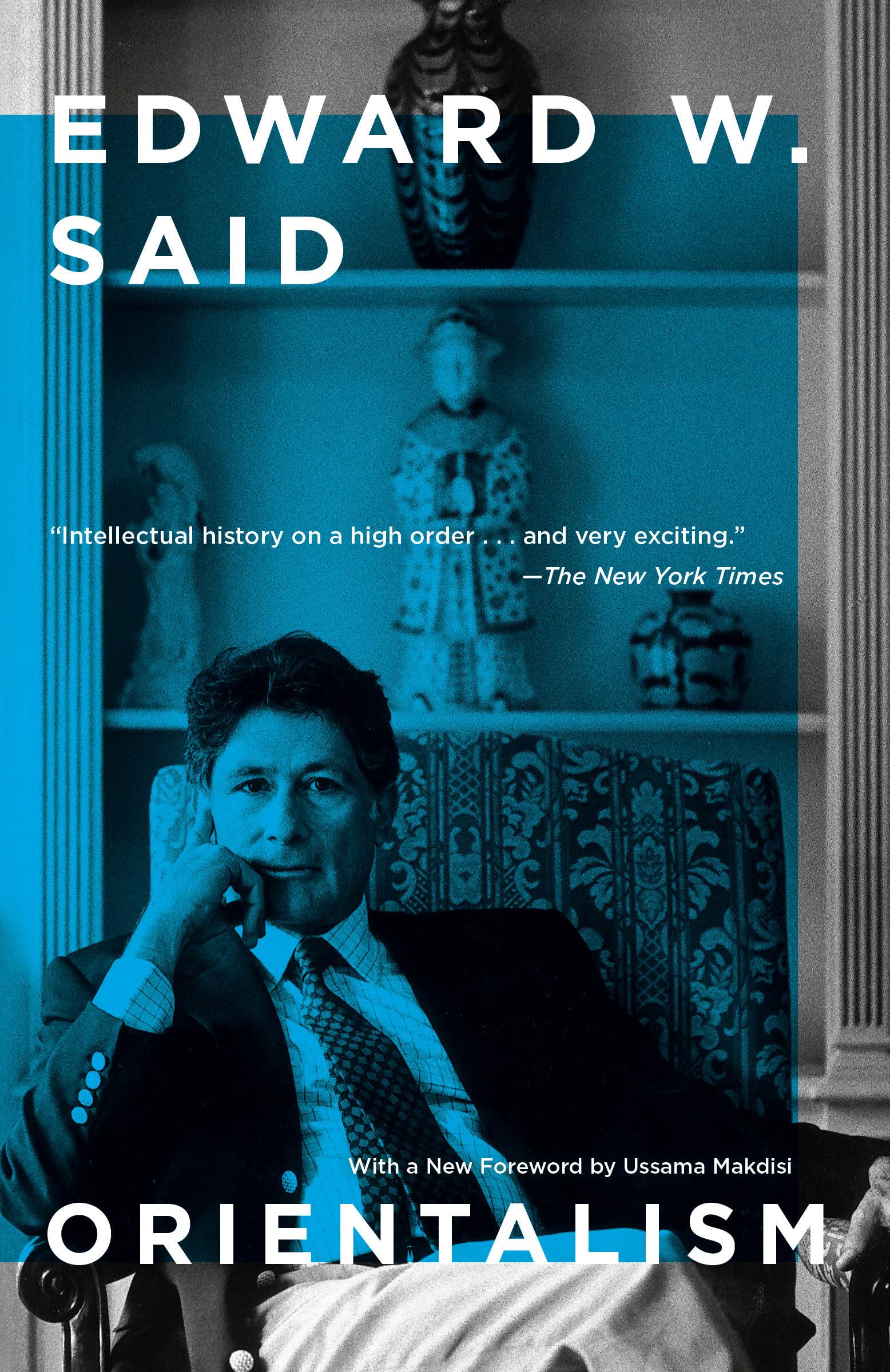Features
My memories of Peretz Shul
 By KINZEY POSEN It was a late Friday afternoon at Peretz Shul in 1964 or so. A good friend of mine at the time whose Yiddish name was Moishe said, “That’s it! I’m not coming back to school on Monday, I’m out of here!” Ok, as an 11 year old, he might have said it in a slightly different way. It was the first day of school in September and we were just about to go home. “Sure you are Moishe, I’m sure you’ll be back on Monday,” I told him.
By KINZEY POSEN It was a late Friday afternoon at Peretz Shul in 1964 or so. A good friend of mine at the time whose Yiddish name was Moishe said, “That’s it! I’m not coming back to school on Monday, I’m out of here!” Ok, as an 11 year old, he might have said it in a slightly different way. It was the first day of school in September and we were just about to go home. “Sure you are Moishe, I’m sure you’ll be back on Monday,” I told him.

Kinzey’s Grade 1 Peretz School class circa 1960
(Thanks to Sandy Shefrin for helping with identifying almost everyone; comments supplied by Kinzey)
Bottom Row crosslegged, left to right: Arthur Greenspan, unidentified, Matthew Levin (a.ka. Moishe in the story)
Second Row (l-r): Paula Wolfman, Rosa Scyzgiel, Shirley Starek, Myra Miller, Faye Golubchuk, Ruthie Rosenzweig,, Honey Leah Berman, Marcie Fleisher
Third Row (l-r): Diane McKay, Lucy Baumel, Janice Goldberg, Howard Kaplan, Sandy Shefrin, Heather Wallace, Pammy Zimmer (Kinzey’s wife, Shayla Fink’s first cousin, a beautiful person (alev hasholem)
Top row (l-r): Sidney Lieber, Martin (Kinzey) Posen, Sheldon Weidman, Harvey Zahn, Harvey Koffman (my first cousin) , Sidney Shoib, Morris Glimcher, Shawn Zell, Miss (Claire) Nelko (who is now Claire Breslaw)
Come Monday, true to his word, my friend did not come back. He had entered an alternate dimension it seemed; he was finished with Peretz Shul! Unheard of! Impossible! How did he do it? Moishe’s act of sedition was a reaction to the Yiddish teacher we had been blessed with that year and he was done. All of us in the class were in awe and Moishe, no worse for wear, having left the school, went on to become a respected ambassador for Canada’s Foreign Service.
A little while back, Bernie asked me to write about Peretz Shul from a different perspective: My own, as a student. I have often wondered why this institution. for those of us who went there, lives so large in our memories. Full disclosure: My grandmother Katya Posen Z’l, nee Gurarie, was one of the founders of Peretz Shul and a lifelong member of the Muter Farein – the women’s organization that helped establish the kindergarten and supported the school.
My father, Abe Posen, attended the school as did his sister, my aunt, Goldie Zuidema Z”l. My dad often told me stories of how various teachers at Peretz used to rent one of the rooms in their house on Burrows. To put it mildly, our family was steeped in Peretzness.
My era began in 1957 when I attended nursery school and then, kindergarten. To this day, I can still smell the matches when our teacher lit the Shabbat candles on Friday and we laid out our little mats to have a nap on. Being a socialist school for the most part, you would think Shabbat would not have been part of the school experience, but I have so many great reminiscences of those two years from making little coloured paper rings several metres long, to receiving the right colour star if we behaved. I loved getting those silver and gold ones alongside my name on the wall – wonderful, warm memories.
Our principal in those early days was Chaver Herstein – an imposing man with a wonderful head of hair and a bit of a temper. We called all our teachers by either “chaver” or “chaverteh” which, in this context, translated to “comrade”. We also called them Leher or Leheren – teacher in Yiddish. Our school was located at 601 Aikins, between Inkster and Polson Avenues. How do I remember the address? Early on as soon as we could write, we always wrote the address at the top of the left corner of the sheet of paper. Now, the building is a health community centre. Once we entered Grade One, our days were separated into half day Yiddish and half day English classes.
Grade One for me – and I am sure for my classmates, was a truly seminal experience. Pushed out of the warm bosom of kindergarten, Grade One meant getting down to serious work. Reading, see Dick run, see Jane run, see Dick and Jane run, writing, singing and my own personal challenge………arithmetic. Our Yiddish teacher, Miss Nelko, was the most beautiful woman who genuinely cared about her students. We loved her and she laid the groundwork for us learning Yiddish and how to be little menches and menchettes. Many years later, Shayla and I received a call about playing a wedding for an older couple. They came over to our house one evening and as we planned the event, it occurred to me that I knew who this woman was: My beloved Miss Nelko, some 40 years later. What a reunion it was!
Our English teacher, on the other hand, had a different style of teaching that could be best described, as adversarial. I renamed her Tyrannosaurus Rex and the invisible scars are still with me. Her approach to learning arithmetic was to say the least, extremely challenging. I was one of those kids who learned math in a different way and in those days, kids such as myself fell through the cracks and we fell deeply. All I remember is after a short explanation of one plus one equals two, etc., we all had to stand up by the blackboard as T Rex wrote a problem on the board. We could not sit down unless we put our hands up and answered correctly. Guess who was often the last kid standing? Me, of course, and I eventually memorized it all so I could finally sit down.
Another time, T Rex distributed to each of us a sheet of paper for some writing project. She gave me what we called at the time “grade one” paper. It’s where the lines were printed with one bold line and two lighter lines and then another bold line. It also had big wood chips in it. I noticed that she was also giving out what we called “grade two” paper. These were all symmetrical bold lines and I wanted one. When she finished giving them out, she asked if everyone received one and me, being me, said, “I didn’t.” My six-year-old brain conveniently forgot that my desk was in the front row and I had scrunched up the grade one paper into a ball and cleverly thought she wouldn’t see it in the wood support for the desk.
As I put my hand up and told her I didn’t get one, she approached my desk in a threatening way, reached into the desk support and said, “What is this?” I was fully chastised, and T Rex bellowed, “You will only get grade one paper for the rest of the year.”
The reality was, in those days, especially in the context of a parochial school, you sometimes had people teaching who were not trained and did not have the skills to do the job. Not only that, more than a few were survivors of the Holocaust and we eventually learned that they experienced terrible horrors in the camps and ghettos.
That being said, I had several wonderful teachers, whose voices to this day still reverberate in my head and I often reflect about their ability to connect and elevate the students.
Mrs. Gold, Mrs. Brooks and Pascal Fishman were some of them. Chaver Fishman came to us from Buenos Aires and was one of our Yiddish teachers. He had a great capacity to see potential in students and encourage them. Another of our teachers, Mrs. Wallace, taught us English and her daughter was in our class for years. The family wasn’t Jewish, but Heather my classmate, spoke Yiddish like a pro. I remember one of our later Yiddish teachers, Mrs. Korman, taught us “Zol Nit Keynmol” the Warsaw Ghetto Song, and led us in a procession to St. John’s Park in the spring, while we sang that song and others.
The year at Peretz Schul was highlighted by two major events. The annual essay contest in Yiddish and English, and the graduation, which took place towards the end of June. For each of those occasions, the auditorium would be absolutely packed and very hot. As students, we often escaped outside to cool off in the lane and we could hear what was going on by the open side doors.
The cultural offerings at Peretz were in my opinion, outstanding. We were taught so many great songs, we acted in plays and we created art. Jewish holidays were celebrated with a Yiddishe taam (Yiddish flavour). Since my Hebrew name was Mordechai/Motel, I always got the part of Mordechai in the Purim play. The music component was delivered by Chaver Bronstein or Mr. Brownstone as he was known at Talmud Torah. His classes were always held in the auditorium, where he’d stand by his easel flipping the song sheets written in Yiddish and we’d follow the words as he used his pointer. Contrary to the Talmud Torah choir experience, he never gave us names or hit us. After he retired, Mrs. Udow took over and when I hoped to join the choir, she said, “Modechai, your voice is changing, perhaps another time.”
After the principal Chaver Herstein retired, Mr. Heilik who was previously at the Calgary Peretz Shul became our new principal. He was an interesting man and because of my ‘occasional’ naughty behaviour, I got to know him a little better than most students. He was an artist. His medium was oil painting and I remember, on one occasion, we were taken out of our class and brought to the auditorium. When we arrived, we saw that all four walls had been covered with his paintings. There were dozens of them. It was a full-blown exhibition of his work.
I bring this up because I became the class artist at Peretz and my teachers often ‘commissioned’ me to draw and colour huge murals in the hallway of the school. This gave me the opportunity to get out of class. Chaver Heilik would always come out of his office to check out my work. My artistry was far below his level, but he was always encouraging and interested in what I was doing.
In my day, we all graduated from Grade Seven and you had the choice of continuing in what was called Mittel Shul. These classes were held after 4 o’clock, after you finished English school. No one in my class went to Mittel Shul and we felt sorry for those who did as they arrived at four, just as we were leaving.
For me, and I’m sure others, the experience of attending Peretz Shul, wasn’t truly appreciated until after we graduated. The real world out there wasn’t as warm and friendly as it was at 601 Aikins. I do know that the school gave me the education that my Baba and other founders were hoping to achieve: an ability to speak Yiddish, a love for the language, Jewish history known as Yiddishe geshicteh and above all, an appreciation for the Jewish people and our incredibly rich journey. I also had my Peretz Shul family, the 12 or so students in my class that I spent 35 hours a week with for nine years. We all take something different away from the experience, but I can guarantee you, many of us, including my friend Moishe the ambassador, will always carry Peretz Shul memories with us for the rest of our lives.
Post script: Ed. note: It didn’t take me too long to figure out who the “Moishe” was to whom Kinzey refers in his article. I was actually friends myself with “Moishe”, although I knew him better as Matthew Levin.
Ed. note: It didn’t take me too long to figure out who the “Moishe” was to whom Kinzey refers in his article. I was actually friends myself with “Moishe”, although I knew him better as Matthew Levin.
Matthew was always very independent-minded – even as a kid. That being said, he went on to an illustrious career in Canada’s diplomatic service. Among other posts he held, he was Canada’s Ambassador to Columbia, Cuba, and most recently Spain.
It was while he was Ambassador to Cuba that Matthew, along with his wife, Rosealba, played an instrumental role in helping Cuban Jews emigrate to Israel (since Israel and Cuba did not have diplomatic relations).
When I read Kinzey’s story I decided to send it to Matthew – before I outed him as the “Moishe” in the story. Matthew was pleasantly surprised to see that Kinzey mentioned him in a story and even further that he referred to him as “Moishe”.
In my email to Matthew I mentioned that the last time I had attempted to contact him was when Stephen Harper was Prime Minister and Matthew was Canada’s Ambassador to Cuba. At the time, some low level functionaries in what is known as Global Affairs Canada interceded and said that I would not be able to communicate directly with Matthew. Instead, I was told, I could submit any questions that I had to Global Affairs, they would vet them (no doubt looking for anything that might potentially embarrass the government, such as asking about Matthew’s boyhood years in Winnipeg).
So, when I reached out to Matthew – again, this time after reading Kinzey’s piece, I said that I didn’t know whether he would even receive my email since I suspected “apparatchiks” in the government would see it first – and probably attempt to prevent me from communicating with him directly – again.
I was surprised then, to receive a very warm response from Matthew – in which he explained that he is no longer under the supervision of government “apparatchiks”.
Here’s what Matthew Levin wrote to me, in part:
Wonderful to hear from you! I’m so glad you made the effort to reach out.
I finished my posting to Spain a couple of months ago and am now back in Ottawa and transitioning to retirement. So no more apparatchiks.
First of all, I hope you’re well and coping successfully with these strange times.
Your lovely message brings back all sorts of very fond memories. It’s a long time since anyone called me Moishe (often shortened to Moish back then). I never saw most of my Peretz Shul classmates after I left the school, as Kinzey recalls, at the start of Grade 5 (a long story). Kinzey was one of the very few I did see occasionally, including a few times when he was playing with Finjan. But most of the others I completely lost touch with. Now I sometimes wonder what has become of many of them. It’s really heartwarming to think that Kinzey (Martin at the time and I believe he was Mordechai in Yiddish, or maybe Mendel) remembered me as he was writing this story. Since you and I and our group of friends never called each other by our Yiddish names I’m surprised, but delighted, that you thought of me when you saw this reference to a Moishe.
Thanks so much for sending along Kinzey’s story. I’m sending you this reply before having read it, because I didn’t want to delay getting back to you, but I’ll certainly read it with great interest and undoubtedly pleasure. I really feel honoured and delighted to be included. If you’re in touch with Kinzey, please thank him and give him a big hug – virtual of course for now – from me.
Features
CAD Performance in 2025: Key Factors Behind Its Recovery

The CAD is clawing back lost ground. Discover what pushed the loonie down in 2024, what’s lifting it in 2025, and why its future still hangs in the balance.
2024 was a strange year for the loonie. If you are an active currency trader, a quick look at a CAD/USD price chart would have you nodding in agreement. Yes, the year started off strong, but as the months rolled by, it was obvious that something was wrong, especially as we neared the end of Q3. The reason for the downtrend was clear. Most people agreed that it was the tariff threats from Washington, rate cuts at home, and a volatile global economy that were being reflected in the currency markets. And for a while, the CAD was stuck in that losing streak, with some experts even suggesting that there was still more to come.
As the new year rolled around, it didn’t seem like anything had changed. But by mid-2025, quiet shifts had turned into a noticeable recovery, with the loonie gaining back significant ground against the greenback. So, in this piece, we’ll break down what really dragged the Canadian dollar lower in 2024, what’s fueling its recovery this year, and whether this rebound is going to hold steady.
Understanding What Happened in 2024
At the start of the year (2024), one U.S. dollar traded for about 1.35 CAD, which translates to one Canadian dollar being valued at roughly 74 cents U.S. It wasn’t anything special at the time, especially after the levels of inflation and volatility of 2023. Still, economists noted that these were the few key factors that kept the loonie afloat early in the year:
- The price of oil made a comeback. Crude prices firmed up early in the year, supporting Canada’s export earnings and adding a tailwind to the currency.
- Employment figures were solid. Job growth held up, and steady wage gains helped offset the pressure of higher borrowing costs.
- The BoC held a steady interest rate. After an aggressive round of rate hikes in 2023, policymakers looked ready to pause and let the economy cool gradually.
All of these factors were thought to have helped build confidence in the Canadian economy and by mid-2024, the loonie had edged up toward 76-77 cents U.S.
Late-Year Turbulence
Not a lot of people saw it, but as Q2 2024 unfolded, the CAD started to look unattractive to currency market investors. How? Well, it started when the Bank of Canada (BoC) started to signal its intention to cut interest rates. It gave its clearest sign to this on April 10, 2024 when the bank highlighted that inflation was slowing down and it was leaving the door open for rate cuts. This announcement changed market expectations almost overnight.
Eventually, the first cut came on June 5, 2024. The BoC lowered its benchmark rate by 25 basis points from 5% to 4.75%, becoming the first major G7 central bank to start easing.
From there, the pace picked up with rates being reduced four more times. The market’s reactions to these cuts were immediate. And any currency trader with a reliable forex trading app saw each one unfold live. The CAD began to lose altitude as the yield gap with the U.S. widened. With lower returns on Canadian assets, investors favored the greenback. Adding to the pressure, the Trump campaign’s 25% tariff threat in September ignited the fears of a trade war. Which led to traders quickly pricing in potential hits to exports and investment, sending sentiment lower.

The 2025 Comeback
The CAD started 2025 trading at around 67 cents U.S., with some days even seeing it flirt with the 66-cent mark. So, it was a common assumption in the currency traders’ community that 2024 might repeat itself. But something was different this time. Every day, the loonie was quietly clawing back much of the ground it lost during the previous year’s slump.
So, what was different this time? Well, experts believe the panic that gripped both retail and institutional traders through late 2024 began to fade. As positive economic data started to filter in, confidence slowly returned alongside a few key drivers. By midyear, analysts were already talking about a turnaround rather than just a recovery attempt. The CAD was trading in the 72-73-cent U.S. range, up solidly from its January lows, and here’s its current rate.
Major Factors Behind the CAD’s Recovery
So, what helped the CAD? Well, there were a few clear factors that came together to turn sentiment around and put the loonie back on steadier footing.
- U.S. Dollar Weakness
A softer U.S. dollar was one of the clearest tailwinds for the CAD in 2025. The weakening of the USD started occurring when investors started to pull back from U.S. assets as political tension, fiscal worries, and softer economic data piled up.
What drove it?
- Trade and political uncertainty: Tariff moves and Washington infighting rattled investor confidence.
- Fiscal strain: Deficit concerns eroded trust in U.S. financial stability.
- Fed policy shifts: With the Federal Reserve showing interest in cutting rates (and actually doing so on September 16), the yield advantage that once favored the dollar began to fade.
As investors reduced exposure to U.S. assets, capital rotated into other major currencies. The CAD, being liquid and commodity-linked, was one of the key beneficiaries, strengthening almost by default as the greenback lost ground.
- Diverging Monetary Policy
Monetary policy divergence became another major driver. The Bank of Canada held its policy rate steady near 2.75% through Q2 2025 before cutting in September, signaling confidence that inflation was cooling without stalling growth. Meanwhile, the U.S. Federal Reserve began easing monetary policy with its first rate cut in September 2025, responding to slowing growth and softer inflation. This divergence in pace and tone helped support the Canadian dollar’s rebound.
This narrowing interest rate gap mattered. And with Canada offering relatively higher yields, foreign investors found the loonie more attractive, especially compared to the softening U.S. dollar. For traders, the CAD started to look like a better carry trade than it had in over a year.
- Easing Tariff Fears
Another major psychological lift came from the fading of tariff risks. In the first half of 2025, Trump’s proposed 25% tariffs on Canadian goods lost traction as political attention shifted elsewhere. While some concerns still lingered, the immediate threat of a trade shock began to ease. Cross-border trade flows regained a bit of momentum, and markets started to price in a smoother path for Canadian exports. That renewed confidence played a key role in supporting the loonie’s recovery.
Can the Loonie Hold Its Ground?
As 2025 moves forward, the consensus among analysts is cautious but constructive. Most expect the Canadian dollar to trade in the 1.33-1.36 range against the U.S. dollar, a level that points to stability. The worst of 2024’s volatility seems to be behind it, but the loonie’s next moves will still depend on how the global story unfolds.

A Currency That Refused to Stay Down
The past two years have been anything but smooth for the CAD, but this move has proven one thing: resilience runs deep. After weathering policy shifts, tariff scares, and market pessimism, the loonie has managed to rebuild its footing in 2025. Its recovery hasn’t been dramatic. It was grounded in solid fundamentals and steady confidence. For traders, that’s a reminder that sentiment can turn just as fast as it fades.
Features
Statistical Volatility Models in Slot Mechanics: Extended Expert Analysis Informed by Pistolo Casino
Analytical reviews of slot volatility often reference ecosystems similar to those found at Pistolo casino. Within the gambling research community, volatility is understood not as a marketing attribute, but as a technical framework that shapes how digital slot systems distribute outcomes over time. Expanding on earlier overviews, this extended analysis examines the deeper mathematical logic behind volatility classes, as well as their implications for long-term behavioural modelling.
Volatility as a Mathematical Architecture
Slot volatility is commonly divided into high-, medium-, and low-risk models, yet this simplified categorisation hides the structural complexity underneath. Developers configure several layers of probability weighting, which include:
- Event Density Layers – Each slot contains multiple weighted segments representing minor, medium, and rare outcomes.
- Return Frequency Curves – These curves dictate how the distribution of payouts drifts around the long-term equilibrium.
- Reel Weighting Matrices – Symbol appearance probability is shaped not only by frequency but also by conditional dependencies within each reel strip.
Research drawing on examples parallel to Pistolo casino shows that modern slots increasingly use modular probability blocks, making outcome variance more flexible and more precisely adjustable during development.
Behavioural Interpretation of Volatility Signals
From a player analytics perspective, volatility modelling helps identify how different user groups respond to varying risk structures. High-volatility mechanics frequently attract users who seek extended tension cycles and the possibility of occasional strong outcomes, while low-volatility systems are associated with steady-state gameplay and longer average session times.
Analysts also examine “volatility fatigue,” a concept describing the moment when prolonged dry cycles reduce engagement. By tracking these patterns, researchers can map how changes in event spacing affect decision-making, bet sizing, and persistence.
Simulation Methodology for Evaluating Volatility Accuracy
Technical audits rely heavily on large-scale simulations—sometimes exceeding fifty million iterations — to verify that the modelled volatility aligns with theoretical expectations. Key indicators include:
- Hit rate stability across long sequences
- Distribution symmetry, ensuring outcomes do not drift into accidental bias
- Deviation corridors, which define acceptable ranges for short-term anomalies
- Return-to-player convergence, showing whether the model equilibrates over time
When discrepancies appear, developers may adjust symbol weighting, probability intervals, or feature-trigger frequency until the system reaches internal balance consistent with regulatory and mathematical demands.
Volatility’s Role in Market Diversity
Volatility modelling helps explain the substantial variety between slot titles. Instead of relying solely on themes or graphics, modern game design differentiates titles by emotional rhythm and progression speed. This technical approach has led to more deliberate pacing structures where reward cycles, anticipation building, and event clustering are calibrated through mathematical systems rather than subjective intuition.
Conclusion
Volatility remains one of the most precise and data-driven components of slot design. Its study provides insight into outcome diversity, behavioural responses, and long-term predictability. Research frameworks referencing platforms comparable to Pistolo Casino highlight how volatility models shape modern gambling environments through measurable probability engineering and large-scale simulation.
Features
Bias in America’s Colleges Produced Modern Anti-Zionism

By HENRY SREBRNIK Jon A. Shields, Yuval Avnur, and Stephanie Muravchik, professors at the Claremont Colleges in California, have just completed a study, “Closed Classrooms? An Analysis of College Syllabi on Contentious Issues,” published July 10, 2025, that draws on a database of millions of college syllabi to explore how professors teach three of the most contentious topics: racial bias in the criminal justice system, the Israel-Palestine conflict, and the ethics of abortion.
They used a unique database of college syllabi collected by the “Open Syllabus Project” (OSP). The OSP has amassed millions of syllabi from around the world primarily by scraping them from university websites. They date as far back as 2008, though a majority are from the last ten years. Most of the data comes from universities in the United States, Britain, Canada, and Australia.
“Since all these issues sharply divide scholars, we wanted to know whether students were expected to read a wide or narrow range of perspectives on them. We wondered how well professors are introducing students to the moral and political controversies that divide intellectuals and roil our democracy. Not well, as it turns out.”
In the summary of their findings, “Professors Need to Diversify What They Teach,” they report that they found a total lack of ideological diversity. “Across each issue we found that the academic norm is to shield students from some of our most important disagreements.”
Teaching of Israel and Palestine is, perhaps no surprise, totally lopsided, and we’ve seen the consequences since October 7, 2023. Staunchly anti-Zionist texts — those that question the moral legitimacy of the Israeli state — are commonly assigned. Rashid Khalidi, the retired professor of Modern Arab Studies at Columbia, is the most popular author on this topic in the database. A Palestinian American and adviser to the Palestine Liberation Organization delegation in the 1990s, Khalidi places the blame on Israel for failing to resolve the conflict and sees the country’s existence as a consequence of settler-colonialism.
The problem is not the teaching of Khalidi itself, as some on the American right might insist. To the contrary, it is important for students to encounter voices like Khalidi’s. The problem is who he is usually taught with. Generally, Khalidi is taught with other critics of Israel, such as Charles D. Smith, Ilan Pappé, and James Gelvin.
Not only is Khalidi’s work rarely assigned alongside prominent critics, those critics seem to hardly get taught at all. They include Israel: A Concise History of a Nation Reborn by Daniel Gordis, a professor at Shalem College in Israel. Gordis’s book appears only 22 times in the syllabus database. Another example is the work of Efraim Karsh, a prominent historian. His widely cited classic, Fabricating Israeli History, appears just 24 times.
For most students, though, any exposure to the conflict begins and ends with Edward Said’s Orientalism, first published in 1978. Said is the intellectual godfather of so many of today’s scholars of the Middle East, thanks in no small part to this classic book. Said was a Palestinian-American academic, literary critic, and political activist from a prominent Christian family. Educated at Princeton and Harvard Universities, two of America’s most distinguished centres of higher learning, he taught at Columbia University, another Ivy League institution, until his death in 2003.
Said was no crude antisemite. His writings were aimed at academics and intellectuals and he has, in my opinion, done more damage to the Jewish people than anyone else after 1945. Said claimed to be the first scholar to “culturally and politically” identify “wholeheartedly with the Arabs.” But he was also a political activist for the Palestinian movement opposing the existence of Israel.
Said warned PLO leader Yasir Arafat that if the conflict remained local, they’d lose. Join “the universal political struggle against colonialism and imperialism,” with the Palestinians as freedom fighters paralleling “Vietnam, Algeria, Cuba, and black Africa,” he advised.
(In this he was not the first, though. Fayez Sayegh, a Syrian intellectual who departed for the United States and completed his Ph.D. at Georgetown University in 1949, preceded him. Also an academic, his 1965 monograph Zionist Colonialism in Palestine stands as the first intellectual articulation of Zionism as a settler colonial enterprise, arguing that the analytical frameworks applied to Vietnam and Algeria apply equally to Palestine. The treatise situated Zionism within European colonialism while presenting it as uniquely pernicious.)
Israel’s post–Six-Day War territorial expansion helped Said frame Israel as “an occupying power” in a 1979 manifesto titled The Question of Palestine. Alleging racial discrimination as the key motive was a means of transforming the “Zionist settler in Palestine” into an analogue of “white settlers in Africa.” That charge gained traction in a post-Sixties universe of civil rights, anti-imperialism, anti-colonialism, and Western self-abnegation. The work sought to turn the tables on the prevailing American understanding of Israel: It is not, in fact, an outpost of liberal democracy or refuge from antisemitism, but an instrument of white supremacy.
Orientalism popularized a framework through which today’s advocates on behalf of Palestinians understand their struggle against the state of Israel and the West generally. Said casts the Western world as the villains of history and peoples of the East as its noble victims.
The essence of the book, Said concluded, is the “ineradicable distinction between Western superiority and Oriental inferiority.” It falsely affirms “an absolute and systematic difference between the West, which is rational, developed, humane, superior, and the Orient, which is aberrant, undeveloped, inferior.”
So it was impossible to take Zionism seriously as one among the myriad nationalist movements that emerged in the nineteenth century, much less to see Israel itself as a land of refugees or the ancestral homeland of Jews. And, indeed, Said’s Orientalism singles out Israel for special rebuke, suggesting that the state could be justified only if one accepted the xenophobic ideology at the core of Western civilization. Israel’s defenders, particularly those who lament the lack of democracy in the Middle East and fault Arabs for their militancy, represent the “culmination of Orientalism.”
Said is widely acknowledged as the godfather of the emerging field of postcolonial studies, and his views have profoundly shaped the study of the Middle East. Said also inspired – and in some cases directly mentored – a generation of anti-Zionist U.S. scholars whose dominance in the academic study of the area is unquestionable today.
The political left that emerged trained itself to read every conflict as the aftershock of colonialism. The ideological narrative of oppression and resistance allowed even the jihadist to become a post-colonial rebel.
It’s hard to overstate the academic influence of Orientalism. The authors note that “As of this writing, it has been cited nearly 90 thousand times. It is also the 16th most assigned text in the OSP database, appearing in nearly 16 thousand courses.” Orientalism is among the most popular books assigned in the United States, showing up in nearly 4,000 courses in the syllabus database. Said’s work appears in 6,732 courses in U.S. colleges and universities.
But although it was a major source of controversy, both then and now, it is rarely assigned with any of the critics Said sparred with, like Bernard Lewis, Ian Buruma, or Samuel Huntington. Instead, it’s most often taught with books by fellow luminaries of the postmodern left, such as Frantz Fanon and Judith Butler.
All these ideas are now embedded into diversity, equity, and inclusion identity politics, and “humanitarian” outrage over supposed Israeli “settler-colonialism,” “genocide,” and “apartheid.”
The ground for the massive pro-Hamas college and university encampments, and attacks on Jewish students, was prepared decades ago. The long march of progressives through American institutions over the past decades has taken its toll on society.
Henry Srebrnik is a professor of political science at the University of Prince Edward Island.


